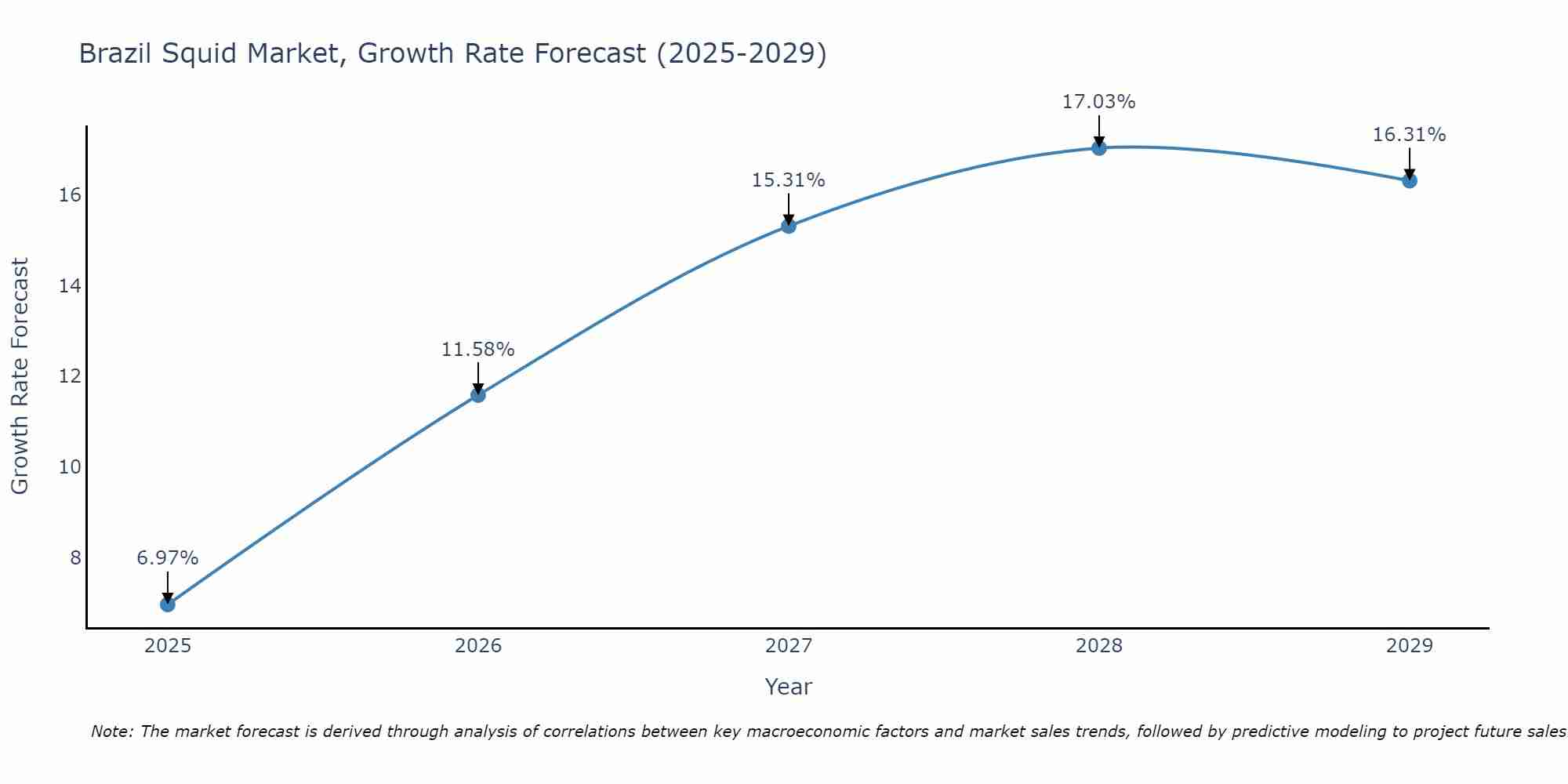Brazil Squid Market (2025-2031) Outlook | Analysis, Companies, Revenue, Size, Share, Industry, Trends, Value, Growth & Forecast
| Product Code: ETC387902 | Publication Date: Aug 2022 | Updated Date: Apr 2025 | Product Type: Market Research Report | |
| Publisher: 6Wresearch | No. of Pages: 75 | No. of Figures: 35 | No. of Tables: 20 | |
Brazil Squid Market Size Growth Rate
The Brazil Squid Market is projected to witness mixed growth rate patterns during 2025 to 2029. Starting at 6.97% in 2025, the market peaks at 17.03% in 2028, and settles at 16.31% by 2029.

Brazil Squid Market Overview
The Brazil Squid Market reflects the diversity within the seafood industry, catering to consumers with a taste for cephalopods. Factors such as catch volumes, international trade regulations, and changing consumer preferences contribute to the market`s complexity.
Drivers of the market
The squid market in Brazil is affected by factors such as oceanic conditions, fishing quotas, and international demand. Market dynamics such as fluctuations in squid populations and processing capabilities can impact both domestic consumption and exports.
Challenges of the market
The Brazil Squid market faces challenges associated with managing fluctuating supply and demand dynamics. Squid is a seasonal catch, and variations in weather conditions and fishing yields can impact market availability. Companies operating in this market must develop effective strategies to handle these fluctuations, including diversifying sourcing locations, implementing efficient storage and distribution systems, and collaborating closely with suppliers to ensure a stable supply chain. Successfully navigating these challenges is essential for maintaining market competitiveness.
Government Policy of the market
The Brazil government implements policies to regulate the squid market, focusing on sustainable fishing practices and resource management. Measures include setting fishing quotas, enforcing gear restrictions, and promoting research on squid populations to ensure their long-term sustainability. Additionally, support is provided to squid fishermen to improve their livelihoods and ensure a steady supply of high-quality squid products.
Key Highlights of the Report:
- Brazil Squid Market Outlook
- Market Size of Brazil Squid Market, 2024
- Forecast of Brazil Squid Market, 2031
- Historical Data and Forecast of Brazil Squid Revenues & Volume for the Period 2021-2031
- Brazil Squid Market Trend Evolution
- Brazil Squid Market Drivers and Challenges
- Brazil Squid Price Trends
- Brazil Squid Porter's Five Forces
- Brazil Squid Industry Life Cycle
- Historical Data and Forecast of Brazil Squid Market Revenues & Volume By Products for the Period 2021-2031
- Historical Data and Forecast of Brazil Squid Market Revenues & Volume By Fresh for the Period 2021-2031
- Historical Data and Forecast of Brazil Squid Market Revenues & Volume By Frozen for the Period 2021-2031
- Historical Data and Forecast of Brazil Squid Market Revenues & Volume By Prepared for the Period 2021-2031
- Brazil Squid Import Export Trade Statistics
- Market Opportunity Assessment By Products
- Brazil Squid Top Companies Market Share
- Brazil Squid Competitive Benchmarking By Technical and Operational Parameters
- Brazil Squid Company Profiles
- Brazil Squid Key Strategic Recommendations
Frequently Asked Questions About the Market Study (FAQs):
- Single User License$ 1,995
- Department License$ 2,400
- Site License$ 3,120
- Global License$ 3,795
Search
Related Reports
- Portugal Electronic Document Management Market (2025-2031) | Strategy, Consumer Insights, Analysis, Investment Trends, Opportunities, Growth, Size, Share, Industry, Revenue, Segments, Value, Segmentation, Supply, Forecast, Restraints, Outlook, Competition, Drivers, Trends, Demand, Pricing Analysis, Competitive, Strategic Insights, Companies, Challenges
- France Electronic Document Management Market (2025-2031) | Strategy, Consumer Insights, Analysis, Investment Trends, Opportunities, Growth, Size, Share, Industry, Revenue, Segments, Value, Segmentation, Supply, Forecast, Restraints, Outlook, Competition, Drivers, Trends, Demand, Pricing Analysis, Competitive, Strategic Insights, Companies, Challenges
- Portugal Occupational Health & Safety Services Market (2025-2031) | Strategy, Consumer Insights, Analysis, Investment Trends, Opportunities, Growth, Size, Share, Industry, Revenue, Segments, Value, Segmentation, Supply, Forecast, Restraints, Outlook, Competition, Drivers, Trends, Demand, Pricing Analysis, Competitive, Strategic Insights, Companies, Challenges
- Netherlands Occupational Health and Safety Services Market (2025-2031) | Strategy, Consumer Insights, Analysis, Investment Trends, Opportunities, Growth, Size, Share, Industry, Revenue, Segments, Value, Segmentation, Supply, Forecast, Restraints, Outlook, Competition, Drivers, Trends, Demand, Pricing Analysis, Competitive, Strategic Insights, Companies, Challenges
- Belgium and Luxembourg Facility Management Market (2025-2031) | Strategy, Consumer Insights, Analysis, Investment Trends, Opportunities, Growth, Size, Share, Industry, Revenue, Segments, Value, Segmentation, Supply, Forecast, Restraints, Outlook, Competition, Drivers, Trends, Demand, Pricing Analysis, Competitive, Strategic Insights, Companies, Challenges
- Russia Women Intimate Apparel Market (2025-2031) | Strategy, Consumer Insights, Analysis, Investment Trends, Opportunities, Growth, Size, Share, Industry, Revenue, Segments, Value, Segmentation, Supply, Forecast, Restraints, Outlook, Competition, Drivers, Trends, Demand, Pricing Analysis, Competitive, Strategic Insights, Companies, Challenges
- Africa Chocolate Market (2025-2031) | Size, Share, Trends, Growth, Revenue, Analysis, Forecast, industry & Outlook
- Global Hydroxychloroquine And Chloroquine Market (2025-2031) | Industry, Trends, Size, Outlook, Growth, Value, Companies, Revenue, Analysis, Share, Forecast
- Saudi Arabia Plant Maintenance Market (2025-2031) | Industry, Size, Growth, Revenue, Value, Companies, Forecast, Analysis, Share & Trends
- Taiwan Electric Truck Market (2025-2031) | Outlook, Industry, Revenue, Size, Forecast, Growth, Analysis, Share, Companies, Value & Trends
Industry Events and Analyst Meet
Our Clients
Whitepaper
- Middle East & Africa Commercial Security Market Click here to view more.
- Middle East & Africa Fire Safety Systems & Equipment Market Click here to view more.
- GCC Drone Market Click here to view more.
- Middle East Lighting Fixture Market Click here to view more.
- GCC Physical & Perimeter Security Market Click here to view more.
6WResearch In News
- Doha a strategic location for EV manufacturing hub: IPA Qatar
- Demand for luxury TVs surging in the GCC, says Samsung
- Empowering Growth: The Thriving Journey of Bangladesh’s Cable Industry
- Demand for luxury TVs surging in the GCC, says Samsung
- Video call with a traditional healer? Once unthinkable, it’s now common in South Africa
- Intelligent Buildings To Smooth GCC’s Path To Net Zero













